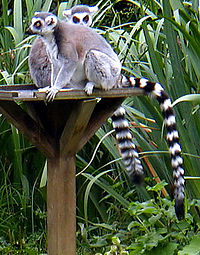
Back Primata ACE Primaat Afrikaans Primaten ALS ሰብአስተኔ Amharic Primates AN رئيسيات Arabic رئيسيات ARZ প্ৰাইমেট Assamese Primates AST Jidoldunol (Primates) AVK
| Primates Temporal range: Palaeocene - Recent
| |
|---|---|

| |
| Olive baboon, an Old World monkey | |
| Scientific classification | |
| Domain: | Eukaryota |
| Kingdom: | Animalia |
| Phylum: | Chordata |
| Class: | Mammalia |
| Grandorder: | Euarchonta |
| Mirorder: | Primatomorpha |
| Order: | Primates Linnaeus, 1758 |

Primates are an order of mammals. It includes all lemurs, monkeys and apes, including humans.[1] Most primates (but not humans) are mainly or entirely forest dwellers.
There are about 400 species of primates.[2] All primates are similar to humans in many ways, but language is an important advantage which only humans have. Other primates have a pattern of calls and gestures, but not language as we know it.
Primates have hands with five fingers and flat fingernails (most other animals have claws or hooves). All primates are covered with fur (hair), but in humans the body hair is only noticeable in two places: on the head and around the genitals.
Primates are split into two groups: Strepsirrhini and Haplorhini. Haplorrhini includes larger monkeys such as, tarsiers and apes including humans. Strepsirrhini includes smaller monkeys such as lemurs, lorises, galagos (also called bush babies) and the aye-aye.
Primates are one of the few mammal groups which re-evolved full color vision. Even so, color vision in birds is better. Color vision was lost in mammals during the long period when dinosaurs ruled the Earth, and mammals were mainly small nocturnal animals.[3]
Close contact between humans and non-human primates creates opportunities for zoonotic diseases to get to humans. Virus diseases transmitted to humans include herpes, measles, ebola, rabies, and hepatitis.
- ↑ Groves C.P. 2005. Wilson D.E.; Reeder D. M. (eds). Mammal species of the world: a taxonomic and geographic reference (3rd ed). Baltimore: Johns Hopkins University Press. pp. 111–184. ISBN 0-801-88221-4. OCLC 62265494
- ↑ Silcox, Mary T.; Bloch, Jonathan I.; Boyer, Doug M.; Chester, Stephen G. B.; López‐Torres, Sergi 2017. The evolutionary radiation of plesiadapiforms. Evolutionary Anthropology: Issues, News, and Reviews. 26 (2): 74–94. PMID 28429568
- ↑ Macdonald, David 2006. Primates. The Encyclopedia of Mammals. The Brown Reference Group plc. pp. 282–307. ISBN 0-681-45659-0